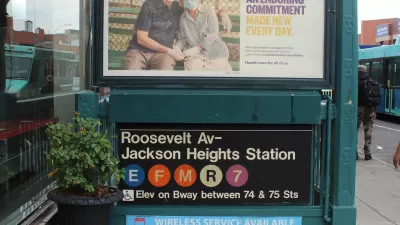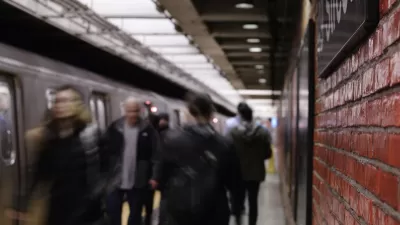Ridership on the New York Subway has a long way to go to return to pre-pandemic normal, and the setbacks of recent months haven't helped the cause.

The New York Times on Sunday published a big feature by Michael Gold, Ana Ley, and James Thomas that digs into the current status of subway ridership around New York City, nearly two years after Covid-19 emerged in its first, brutal wave in the Big Apple and produced one of the first obvious signs of the intersecting concerns of planning and the pandemic.
According to the article, the return of riders to the nation's premier subway system has been uneven depending on location. "Stations in lower-income areas in Brooklyn, Queens and Upper Manhattan, where residents are less likely to be able to work from home and typically depend more on public transit, have rebounded far faster than stations in office-heavy sections of Manhattan, including some that were once the busiest in the system, where many workers are still able to work remotely," write Gold, Ley, and Thomas.
Overall, ridership is still far below pre-pandemic levels. Average daily ridership in November was at 56 percent of pre-pandemic levels—a marked improvement from the 90 percent reduction in trips recorded in spring of 2020, but still far from normal. Recent challenges have worsened ridership—the Omicron variant has sickened Metropolitan Transportation Authority employees, leading to service cuts, and kept more potential riders at home.
"The system is also contending with fears about crime and public safety that were amplified after a woman was shoved to her death in front of a train on Saturday by a man at the Times Square station," according to the article.
Focusing on the varied experiences of the subway in 2022—depending on location and the surrounding economic and demographic factors—the article surveys multiple stations around the system for data and human interest anecdotes. Time lapse video at each station help capture some of the effect in the aggregate.
FULL STORY: Here’s Where Subway Riders Have Returned. And Where They Haven’t.

Study: Maui’s Plan to Convert Vacation Rentals to Long-Term Housing Could Cause Nearly $1 Billion Economic Loss
The plan would reduce visitor accommodation by 25,% resulting in 1,900 jobs lost.

North Texas Transit Leaders Tout Benefits of TOD for Growing Region
At a summit focused on transit-oriented development, policymakers discussed how North Texas’ expanded light rail system can serve as a tool for economic growth.

Using Old Oil and Gas Wells for Green Energy Storage
Penn State researchers have found that repurposing abandoned oil and gas wells for geothermal-assisted compressed-air energy storage can boost efficiency, reduce environmental risks, and support clean energy and job transitions.

Santa Barbara Could Build Housing on County Land
County supervisors moved forward a proposal to build workforce housing on two county-owned parcels.

San Mateo Formally Opposes Freeway Project
The city council will send a letter to Caltrans urging the agency to reconsider a plan to expand the 101 through the city of San Mateo.

A Bronx Community Fights to Have its Voice Heard
After organizing and giving input for decades, the community around the Kingsbridge Armory might actually see it redeveloped — and they want to continue to have a say in how it goes.
Urban Design for Planners 1: Software Tools
This six-course series explores essential urban design concepts using open source software and equips planners with the tools they need to participate fully in the urban design process.
Planning for Universal Design
Learn the tools for implementing Universal Design in planning regulations.
Ascent Environmental
Borough of Carlisle
Institute for Housing and Urban Development Studies (IHS)
City of Grandview
Harvard GSD Executive Education
Toledo-Lucas County Plan Commissions
Salt Lake City
NYU Wagner Graduate School of Public Service





























